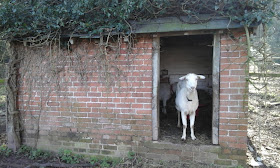We’ve had our Great British Summer – sunshine and 80F for
three days in a row – and most of the young pheasants are in their pens in the
woods enjoying it too. Fledglings in the
garden find new and interesting ways to put themselves in danger while learning
to fly. I’ve re-nested (is that a thing?) a few blackbirds from the ground before
the dogs found them and ate them.
Four
sparrows fell down the chimney over the past few days, so I’ve taken to leaving
the wood stove door open. When I find them flap-hopping over the furniture, I
just pop them out an open window. The morning bird song is still tremendous, so
I guess the song bird population is doing pretty well this year despite all
that.
We’re filling our freezers for the coming shoot season.
Underkeeper Ian shot a muntjac deer trying to break out of a pheasant pen. The
estate has let us keep the deer for our freezer (and beaters’ lunches). I put a
goat in the freezer too – the female half boer goatling that came with my
milkers. We’d sold her, but she came back to live with us. She wouldn’t gentle
or tolerate being handled by humans, so she became meat.
With that one exception, our goats are a pleasure to handle
and nearly as companionable as the dogs. The two does are giving milk, though
I’ve left the kids on their mother. I only milk her out, about a pint, to
relieve any pressure or balance up her udders. Kids and lambs both seem to
favour one teat and a doe / ewe ends up full on one side, milked on the other.
This can lead to mastitis, and certainly it’s less than comfortable for the
mother. I swear you can see the sense of relief on a goat’s face when you milk
out a full side, then rub teat cream on to soften the skin. I brush them both after milking too. It’s an
outdoor goat beauty parlour.
I enjoy the milking process but, with age and wear, my elbow
and wrist joints hurt. Milking by hand every day doesn't give my joints any time to heal. I
looked online for small portable milking machines but the only options I could
find were a) still reliant on using one’s hand to pump or b) upwards of £1000
to buy. No kidding. (Excuse the pun.)
I started searching for a design that I could build myself.
Preferably on the cheap. Preferably
something that runs on batteries as there’s no electricity in the goat paddock.
And portable. But still cheap. I mentioned that, right?
I found Sherri Chekal at Windhaven Farm, a milking mastermind who designed just the
thing by re-working a food saver pump. Sherri offers step-by-step instructions on her website to build your own portable goat milker. I was so thrilled to find her design and emailed her to thank her, and to point out her genius. Sherri's gracious response was "Aw shucks".
All I needed to buy was a syringe, some food-grade tubing,
the largest Kilner jar I could find, and the Food Saver pump. I scavenged pipe joiners from parts we use to
build water systems for pheasant pens and sealed them in place with silicon. I
was so excited to test drive my new milker that I didn’t even change out of my
pyjamas that morning to milk the goats. Wellies on, and I was ready.
It worked!!
I milked the goats and saved my old joints. The
goats didn’t mind the pump milker either. When I'm done milking, I bring the food
saver pump home and plug it into a kitchen socket to recharge, ready for the
following morning. Total cost? Less than £40!
At the moment, a litre of my fresh goat milk is being taxed every
day by this little ewe –
She’s one of the twins born to the ewe with mastitis / tumors. That
ewe had enough milk to feed one of the twins, but not both. I bottle fed the smaller lamb but left her to grow up with her mom in the flock..
The lamb knows that my milking time is her breakfast time, and she chases the
Land Rover shouting for her share. Once she’s finished, she runs back to be
with her mother and brother, so it’s the best of both worlds for her.
The goats have provided us meat, milk, cheese, a sense of
achievement (building my own milker) and entertainment value. I provide them
with the best husbandry I can, and occasionally with their favourite treats:
nachos. They also like asparagus spears, banana skins, raisins, broad bean
pods, and bread. But mostly nachos.
Ole goats!











